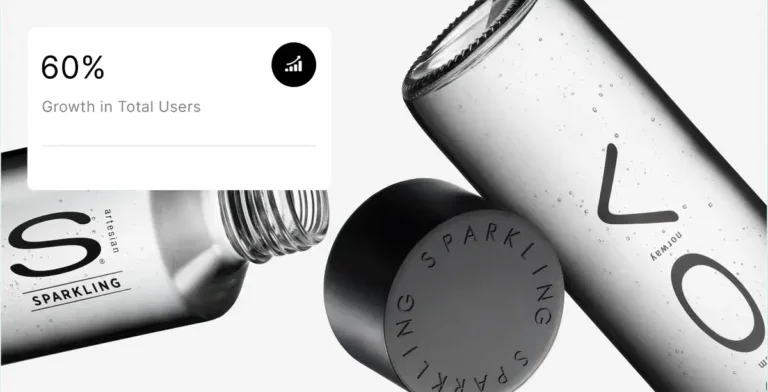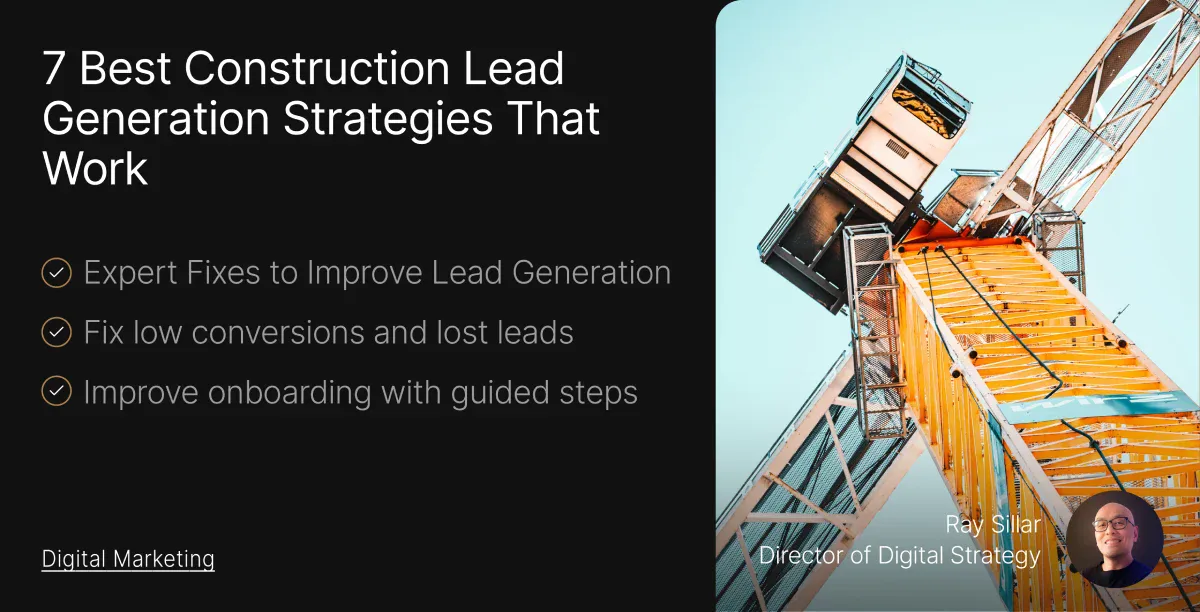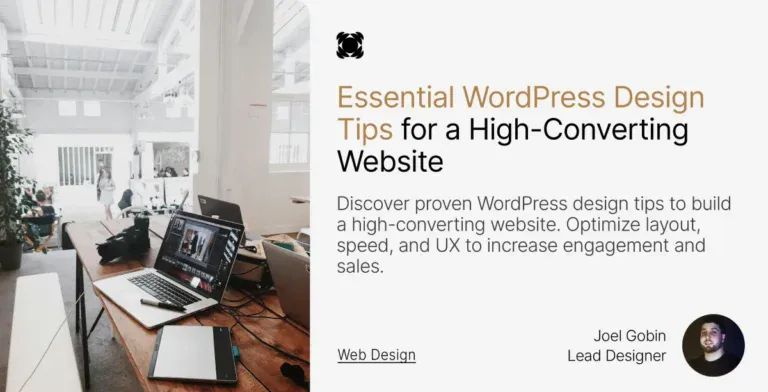Did you know that 81% of consumers need to trust a brand to consider buying from it?
This means if you want to generate leads, you need to strategize and create plans that help consumers trust your construction company first.
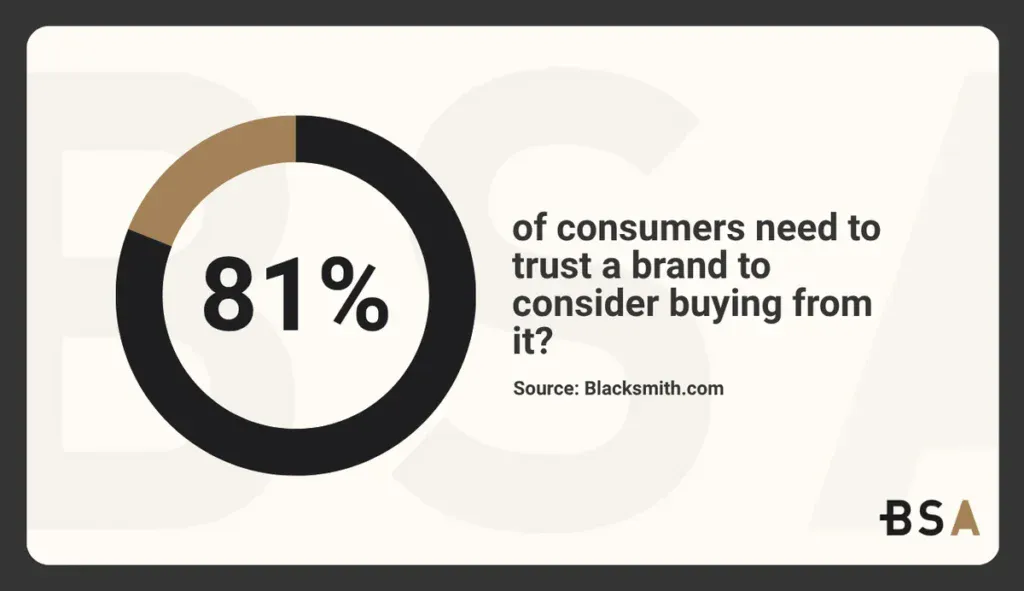
But high-quality construction lead generation is hard to get these days. Many companies compete aggressively to catch homeowners, developers, and businesses’ attention. A company needs more than basic marketing to stand apart.
Better leads generation doesn’t just improve numbers; they reshape your business outcomes completely. Companies that master lead nurturing generate 50% more sales-ready leads at 33% lower cost. These numbers clearly show why your construction company needs the right strategies to grow.
Modern strategies give you amazing ways to reach potential clients. Your content marketing efforts can bring three times more leads than traditional methods while costing 62% less.
Lead generation success depends on both numbers and quality. Smart approaches don’t just pull prospects in; they turn them into repeat customers.
This piece shows you seven tested construction lead generation strategies that work. You’ll learn useful ways to improve your online presence and build trust through social proof. These techniques will help fill your pipeline with qualified prospects who want to build with you.
Want to create a new construction website but don’t know where to start? We can help.
1. Optimize Your Google Business Profile
Your Google Business Profile (GBP) acts as your construction company’s digital storefront. It creates the first impression on potential clients who search for contractors nearby.
This free tool can turn casual browsers into qualified leads when you optimize it properly.
Google Business Profile benefits for construction lead generation
Construction websites can earn great returns from a well-run GBP as they seek new clients. The profile shows up in local searches such as “contractors near me” or “construction services” in specific locations.
Google gives priority to businesses that maintain complete profiles in local search results. The ranking depends on your location, relevance, and prominence.
Companies that stay active with their profiles see better results. Their organic visits increase on both profiles and websites. They rank higher in local searches and attract more qualified leads.
A properly optimized profile can boost purchases by 50% and physical visits by 70%.
Your GBP’s credibility matters too. Businesses with updated listings earn trust from more than 75% of consumers. Construction companies need a solid reputation, and this trust directly helps generate more leads.
How to optimize your Google Business Profile
Your profile needs accurate and detailed information in every section:
Perfect your NAP details: Your business name, address, phone number, website URL, and operating hours should match your website and other directories exactly. This consistency proves your legitimacy to Google.
Select precise categories: Pick a specific primary category that matches your construction website specialty instead of using “contractor” alone. To cite an instance, see how “Pond Contractor” works better than just “Contractor.” Add relevant secondary categories that cover your service range.
Define service areas clearly: Google thinks you only serve your local city unless you set specific areas. You won’t appear in searches from potential clients 30-50 minutes away, even if that’s part of your regular service area.
Detail your services: Write detailed descriptions of your construction services. Use keywords that potential clients might search for. The Products/Services section should list specific offerings like “Kitchen Remodeling” or “Commercial Roofing.”
Collect and manage reviews: Ask happy clients to leave reviews after project completion. Make it easy by sending personalized requests with direct links. Your professional responses to all reviews show Google you’re active and build trust with potential clients.
Common mistakes to avoid with Google Business Profile
Construction companies often miss leads because of these GBP errors:
Inconsistent business information: Your local search rankings suffer when your address, phone number, or business name don’t match across your GBP, website, and directories. Google needs consistent information to trust your business.
Neglecting photos: Empty or outdated galleries make profiles look abandoned. Clients choose competitors who show better visual proof of their work.
Ignoring reviews: Your visibility and trustworthiness depend on reviews. Companies that don’t manage client feedback lose business to competitors who do.
Incomplete service descriptions: Unclear or missing descriptions leave clients guessing about your capabilities. They often contact competitors who explain their services better.
2. Leverage Content Marketing and SEO for Construction Lead Generation
Search engines connect your construction company with clients looking for your services.
Strong SEO and content marketing lead customers from their searches right to your business.
Why SEO matters for construction companies
Your business needs to be visible where customers look. Only businesses on the first page get noticed; just 0.63% of people click to the second page.
SEO gives construction companies big advantages beyond visibility. It brings in better leads by reaching users who search for your specific services.
Unlike regular ads that target everyone, SEO connects you with people who are already interested in what you do.

Your marketing budget goes further with SEO than traditional channels. Data shows it brings lasting results at lower costs. Construction companies that use SEO get many more qualified leads than those sticking to traditional methods.
Content types that attract construction leads
Good content helps construction companies show their expertise, build client trust, and grow in a tough market. Several content types work great for getting construction leads:
Project galleries with before-and-after shots prove your craftsmanship. These pictures build trust with potential clients who want proof of your work. Use quality photos with descriptive file names that include local keywords.
Case studies of successful projects tell stories about your work and show how you solve problems. Prospects see how you’ve handled challenges like theirs.
Video content with project walkthroughs, tutorials, and client stories gives visual proof of your services. Videos really grab the attention of prospects who are just starting their search.
Downloadable guides or checklists that ask for contact details help generate leads. You get valuable prospect information while giving them something useful right away.
Tips for optimizing blog posts and landing pages
Use header tags (H1, H2, H3) to organize your content clearly. This helps readers find what they need and search engines understand your pages. Each service needs its own page with detailed information instead of cramming multiple services together.
Link related pages together to help visitors and boost your SEO. Your main renovation page should link to specific content about kitchen remodeling.
Post new content regularly. Weekly blogs, monthly newsletters, and quarterly case studies keep your business active. Regular updates signal to search engines that you’re engaged.
Use analytics to see which content works best with your audience. Watch your traffic, engagement, conversion rates, and leads; then adjust your strategy based on what you learn.
Share your content everywhere after publishing. Use social media, newsletters, and guest posting to reach more people and build authority.
Explore how we increased R&O Construction’s user engagement by 126% in our latest case study.
3. Use CRM and Marketing Automation Tools
Your construction business can turn regular prospects into valuable leads by managing client relationships effectively.
CRM systems help construction companies track, nurture, and host these relationships throughout the sales process.
How CRM helps generate construction lead generation
Use CRM software to centralize client information for your construction business. This lets you track interactions and find sales opportunities more easily.
CRM systems prevent leads from slipping away during the lengthy construction sales cycle once they enter your pipeline.
CRM platforms let you segment leads by project type, budget range, or timeline. This helps create individual-specific follow-up messages that address their specific needs. Targeted messaging can boost conversion rates by up to five times compared to generic methods.
Construction companies handle complex proposals and multiple stakeholders. CRM tools provide key project tracking features. They help monitor how decision-makers engage with proposals. They also track follow-up deadlines and coordinate team responses. This turns messy lead management into an efficient process.
Top CRM tools for construction companies
Several CRM platforms come with specialized features for construction businesses.
Buildertrend combines CRM functionality with project management tools designed specifically for contractors and builders. The platform’s pre-sale tools help you manage leads and create proposals. They also track client communications.
Plus, they blend seamlessly with your project execution phase after deals close.
JobNimbus addresses home service contractors’ and remodelers’ unique needs. Its interface tracks leads from first contact through project completion and includes specialized features to create estimates and handle storm or disaster-related reconstruction projects.
Followup CRM exclusively serves commercial contractors. The platform makes bidding processes efficient and offers specialized tracking for complex commercial construction project sales cycles.
Salesforce delivers enterprise-level features with extensive customization options. Though it needs more setup than industry-specific options, its powerful analytics and reporting suit larger construction firms managing high-value deals across territories.
Best practices for CRM automation
Your CRM’s potential grows with strategic implementation. Create standard lead capture processes across all entry points. This ensures that all lead information transfers into your system accurately.
Set up automatic email sequences when specific actions occur, such as downloading your “Kitchen Remodeling Guide” or requesting a quote. These sequences should deliver value while guiding prospects through your sales funnel.
Your team should create scoring systems to prioritize follow-ups based on lead behavior. Serious actions, like asking for site visits or downloading pricing info, should have higher values. Casual engagement, such as reading blog posts, deserves lower values.
4. Build Trust Through Reviews and Social Proof
Your construction business’s online reputation plays a huge role in generating leads. Trust shapes hiring decisions in this industry, and your online reviews can turn casual browsers into paying clients.
Importance of online reviews in lead generation
Reviews work as modern word-of-mouth for construction companies. Your business’s digital reputation creates first impressions, and 91% of homeowners consider online reviews significant in their decisions. This digital trust decides which construction companies get on the project shortlist.
Google rewards construction businesses that have many positive reviews with higher search rankings. Better visibility puts your company in front of more people who need construction services.
Reviews deeply influence consumer psychology.
About 75.5% of customers trust online reviews to make decisions.
How to collect and manage reviews
You need a solid plan to get reviews. Ask satisfied clients right after you complete their projects.
Face-to-face requests work best. Thank your customers, tell them how reviews help you grow, and show them where to leave feedback.
Make it easy for clients to leave reviews:
- Business cards with QR codes linking directly to your review pages.
- Personalized email templates with direct review links.
- Text messages with concise instructions and links.
- Incentives like discounts on future services (without buying reviews).
Managing reviews matters just as much as getting them. Respond to all reviews within 24 hours, if possible.
Thank clients who leave positive feedback and highlight what made them happy. For negative reviews, thank the customer, address their concerns, and offer solutions.
Platforms to showcase your construction reviews
Google Business Profile is the lifeblood of construction review management.
This platform guides local search results and helps with construction lead generation.
Show your reviews everywhere:
- Feature testimonials on your website through dedicated pages or widgets.
- Share great reviews on social media to reach more people.
- Include positive feedback in proposals and bid documents.
- Create video testimonials from your happiest customers.
This approach ensures your social proof reaches potential clients whatever platform they use to research construction services.
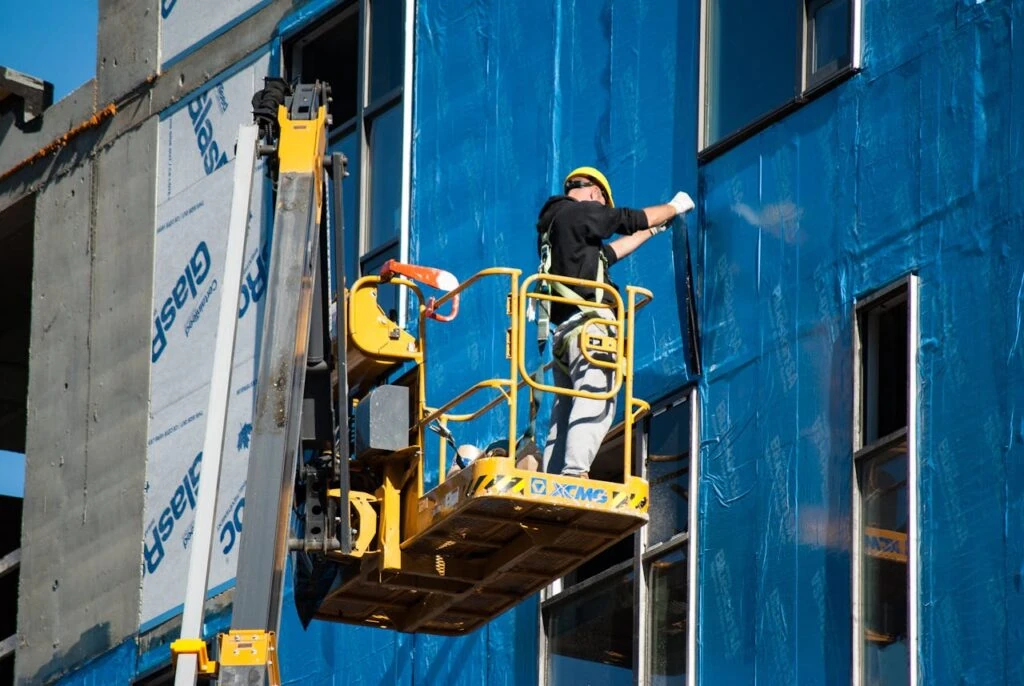
Managing reviews on these platforms can boost client satisfaction. This, in turn, generates leads and creates new construction opportunities.
5. Engage in Local Networking and Community Events
Digital marketing may be on the rise, but face-to-face connections remain vital for construction companies looking for quality leads.
Research shows that over 65% of construction contracts stem from previous relationships or direct referrals. This proves networking’s tangible value in keeping your project pipeline full.
Why local networking still works
Relationships in construction determine which projects you’ll get a chance to bid on. Your local community’s reputation directly affects your lead quality and quantity. Face-to-face interactions build trust that digital marketing can’t match alone.
Local networking lets you spot new projects early. You’ll stay ahead of competitors who only use digital outreach. This early knowledge gives you vital advantages during bidding.
Virtual networking adds to traditional approaches without losing connection quality. Your construction business can reach more prospects and connect beyond geographic limits.
Types of events to attend for lead generation
Industry associations connect you with decision-makers. Groups like the Associated General Contractors of America (AGC), the Construction Management Association of America (CMAA), and the National Association of Home Builders (NAHB) link you directly with potential clients and partners.
Trade shows pack a punch as lead sources. Events like The International Builders’ Show and Construction Super Conference draw top professionals. You’ll meet potential clients in person and answer their questions right away.
Local chambers of commerce connect you with community business leaders. These relationships often spark unexpected projects through referral networks.
Learn how we improved Bragg Companies’ organic traffic by 75% in our recent case study.
6. Run Targeted Paid Advertising Campaigns
Paid ads help construction companies get noticed fast. They connect directly with people looking for services. The right approach brings qualified leads and lets you control spending and targeting completely.
Best ad platforms for construction lead generation
Google Ads rules the construction advertising world. Your potential clients will find you right when they search for the services they need.
Local construction businesses benefit from Google Local Services Ads that show up above regular search results. These ads use a pay-per-lead model to make your budget work harder.
Facebook and Instagram (Meta) are great for showcasing the visuals of your construction projects.
LinkedIn serves commercial construction companies well. The platform attracts millennials as its largest user group, followed by the 18-24 age demographic. This makes it perfect for B2B construction services that target younger property developers or business owners.
How to set up a high-converting ad campaign
The first step is to identify your specific target audience. Your choice between homeowners or commercial developers affects your platform and messaging.
Your budget should match market reality based on competitors and keywords. Ad content needs high-quality project photos or videos that make a strong visual impact. Keep your copy clear and brief. Share information about your services. Mention that you are bonded and insured to build trust.
Then, include a strong call to action, encouraging prospects to contact you.
Each service needs its own landing page instead of sending everyone to your homepage. This targeted strategy boosts conversion rates by matching what your ads promise with relevant landing page content.
Tracking ROI from paid ads
Watch key performance metrics like click-through rate, conversion rate, and cost-per-lead. Construction companies typically see a 1.9% conversion rate on Google advertising. This gives you a baseline to measure your campaign’s success.
A/B testing helps improve your results. Try different headlines, images, or calls-to-action to see what appeals to your audience most.
Regular evaluation and optimization helps construction businesses achieve around 200% ROI on their PPC investments.
7. Implement Referral and Loyalty Programs
High quality construction lead generation comes most powerfully from referrals.
Your satisfied customers become champions of your brand and create a steady flow of pre-qualified prospects who trust your services before you even meet them.
How referral programs generate construction leads
Word-of-mouth marketing is more effective with smart referral programs. These programs inspire existing clients to share your construction business with others.
Trust determines which companies get hired in construction, and these programs use existing relationships to grow your client base.
Referred prospects close faster and deliver better margins since trust already exists. These warm introductions arrive with built-in credibility, which makes sales cycles shorter and reduces acquisition costs.
Tips for launching a successful referral program
Qualified referrals and reward distribution need clear terms. Your CRM system should track every referral and capture referrer details while setting payout reminders after project completion.
Promote your program consistently. Use your website, social media, emails, and face-to-face meetings.
Get a Custom Website That Increases Conversions With Blacksmith
Strategic planning and consistent execution are essential for construction lead generation. These seven strategies can give your construction business distinct advantages. Your results will improve when you use these methods together instead of separately.
But let’s face it, it won’t matter how good your lead generation strategies are if your website isn’t good. You need a website that stands out and delivers on everything that your lead generation strategy tells consumers about.
But creating an exceptional website takes weeks of planning and execution. This is time you could be using for other aspects of your construction business.
So now what?
That’s where we come in. Blacksmith is a construction website design agency with a group of seasoned web designers ready to create the perfect construction website for your business. We’ll ensure your website stands out from your competitors while also having high conversion rates.
Unsure if investing in a custom construction website is what your construction company needs? Don’t worry, click here to schedule a call with us and we’ll audit your current website for free. This way, we can show you all the areas that your current website might be struggling with and how a new website could fix those problems altogether.

